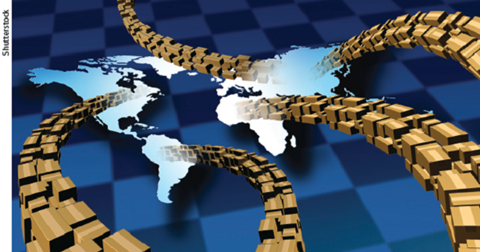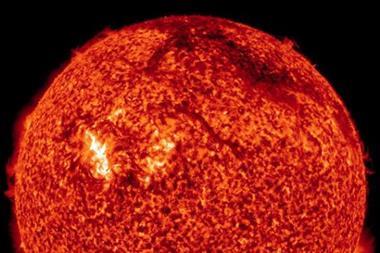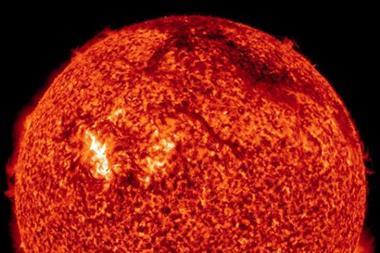A catastrophic solar storm that takes out US generating capacity could result in business interruption and supply chain losses in the United States and around the world of more than $470 billion

We know from historical examples that extreme space weather can be a threat to human technology, but a great deal of uncertainty remains about the potential consequences for business.
The Helios Solar Storm Scenario is a hypothetical example, based on historical and contemporary evidence, of such an extreme event and offers businesses a way of examining their vulnerability and resilience.
This scenario depicts a solar storm that is capable of damaging or, in the most extreme scenario variants, even destroying extra high voltage transformers. In what is known as a coronal mass ejection, the sun throws out a massive explosion of billions of tons of charged particles and magnetic fields that hit the earth with less than an hour’s warning. Its effects, initially on the United States, would spread out into the world through supply chains.
Through direct damage and indirect debilitation of the power grid, Helios would cause immediate power blackouts initially affecting 90 million US citizens or 28% of the US population. The outage would cascade to interdependent infrastructure systems that depend on power, so disrupting transport, digital communications and water, health and financial services.
Interruptions to satellite operations would already have affected business sectors that rely on Global Navigation Satellite Systems for timing, positioning, communications, and synchronisation. These include high-frequency financial trading, transport, oil and gas exploration, agriculture and utilities.
To estimate a range of possible impacts, we look at three variants of the scenario which explore different damage distributions and restoration periods: standard, severe and extreme. In the standard version, it takes three days to restore power to the majority of those affected, thus by day 4 only 14 million citizens are without power.
Supply chain losses
Most damaging to businesses in the US and abroad would be disruption to supply chains and reduced demand. Globally, these are estimated to have an impact of at least $470 billion, but possibly as high as $2.7 trillion for the most extreme scenario variant. Much of this loss could be uninsured. For example, a manufacturer suffering a power outage could be a nominated Tier 1 critical vendor for a manufacturer not affected by the blackout in another country. The overseas manufacturer’s contingent business interruption policy could require that the critical vendor suffered physical damage, not just an extended power failure, for the policy to respond.
The total indirect US supply chain impact is similar size to the direct shock. Shocks to the international supply chain, stemming from US imports and US exports, are estimated to be about one-quarter the size of the overall direct US shock. These would be split between supply and distribution networks. China, Canada and Mexico, as the three largest trade partners of the United States, would be the most severely affected.
At the industry sector level, US manufacturing would suffer the greatest direct impact: between $30 billion for the standard variant and as much as $170 billion at the most extreme. Indirect effects would add a further $30 billion to $180 billion.
Sectors involved mainly in the production of goods and services for end-consumption, such as construction, retail trade, health care and social assistance, accommodation and food services, and public services can be seen as most vulnerable to supply constraints. Conversely, sectors that provide support services to the rest of the economy, such as finance and insurance, professional, scientific and technical services, and administrative and waste management services, would suffer primarily from reductions in demand.
Most affected US sectors by direct and indirect supply chain losses
1. Manufacturing
2. Finance and insurance
3. Government
4. Real estate, rental and leasing
5. Professional, scientific and technical services
Changes in US demand for foreign goods and services account for slightly greater share (57%) of overall indirect impacts, reflecting the general position of the United States in the global value chain. However, this overall figure varies from country to country. For example, Russia, India and Canada have a higher than average impact from reduced US imports, while South Korea and France have a higher than average impact from US export shocks.
Managing the risk
We estimate a range of US insurance industry losses resulting from three variants of the scenario between $55.0 and $333.7 billion. Of this, just over 90% of the claims would come from service interruption coverage from property insurance policies for those who have lost power. Clearly, the power industry would suffer the immediate hit from the storm, but physical damage is only likely to cause about 1% of potential losses to US insurers. A loss of this size would inevitably spread to the US and international reinsurance markets.
| Scenario variant | Direct shock | Indirect shock | Total shock | |||||
|---|---|---|---|---|---|---|---|---|
| US ($bn) | % US GDP | US ($bn) | % US GDP | Non-US ($bn) | % non-US GDP | Global ($bn) | % global GDP | |
| Standard | 217 | 1.4 | 202 | 1.2 | 55 | 0.1 | 474 | 0.7 |
| Severe | 701 | 4.6 | 652 | 4.3 | 178 | 0.3 | 1,532 | 2.2 |
| Extreme | 1,232 | 8.1 | 1,147 | 7.6 | 314 | 0.6 | 2,693 | 3.9 |
The Helios Solar Storm Scenario focuses on the United States, but there is increasing interest elsewhere in understanding extreme space weather as an emerging risk. The Bank of England Prudential Regulation Authority, for example, in 2015 included a solar flare/geomagnetic storm as one of the 11 stress tests recommended for insurers. Lloyd’s offers a space weather event scenario as part of its realistic disaster scenarios.
The Helios Solar Storm Scenario demonstrates that the value of understanding the economic impact of space weather risks is not limited to the insurance industry. Nor is it just electricity utility companies who are concerned with catastrophe scenarios. Many businesses can use such a scenario to improve mitigation procedures and risk strategies, and as a guide where limited resources should be allocated to improve resilience.
Simon Ruffle is director of research and innovation for the Cambridge Centre for Risk Studies at the University of Cambridge Judge Business School. Centre research associate Edward Oughton and research assistant Jennifer Copic also contributed to this article.
Some historical extreme space weather events affecting earth
1859 - The Carrington Event, regarded as one of the largest ever solar storms, caused significant disruption to telegraph systems.
1921 – Similar in size to the Carrington Event, a storm caused fires at several telegraph stations in Sweden.
1958 – Transatlantic communications were disrupted between Newfoundland and Scotland. There was a blackout in the Toronto area.
1989 – It took only 90 seconds for the entire Quebec power grid to collapse. The well-documented Quebec power outage lasted nine hours.
2003 – The Halloween Storms led to a one-hour power outage in Sweden, a radio blackout of high frequency communications and disruption to GPS systems.




















No comments yet